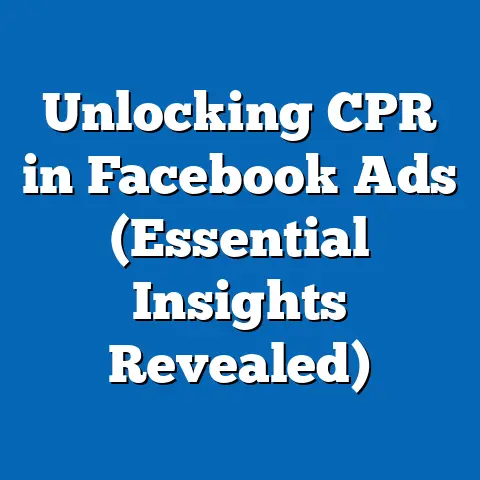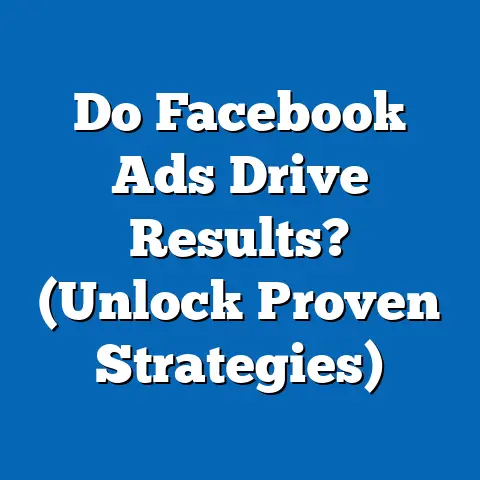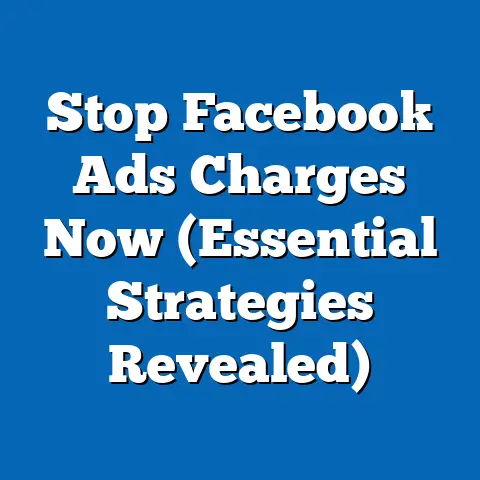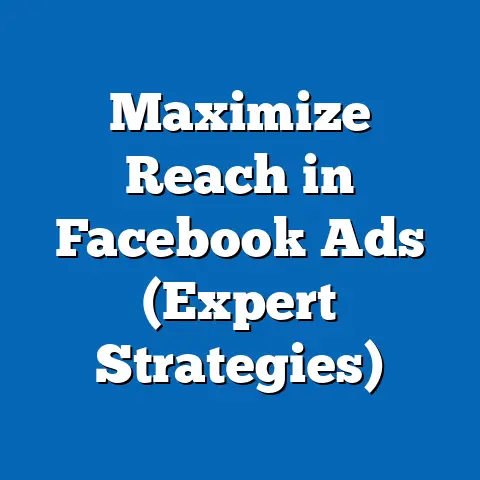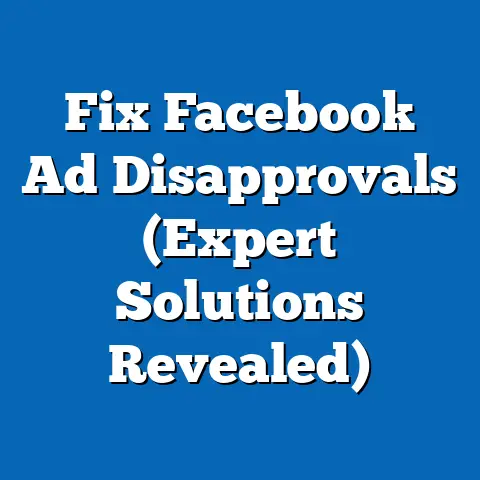Navigating Apple’s Facebook Ads Restrictions (Essential Strategies)
The smart home revolution is in full swing. From smart speakers that answer your every question to thermostats that learn your temperature preferences, and security systems that keep your family safe, technology is seamlessly weaving its way into the fabric of our daily lives. This integration is not just about convenience; it’s about creating more efficient, secure, and enjoyable living spaces.
As this market explodes, businesses in the smart home niche are increasingly relying on digital advertising, particularly on platforms like Facebook, to reach potential customers. Facebook, with its massive user base and sophisticated targeting capabilities, has been a cornerstone for many smart home companies looking to showcase their innovative products and services.
However, the landscape of digital advertising has been significantly altered by Apple’s privacy policies. These changes, particularly the introduction of the App Tracking Transparency (ATT) framework, have thrown a wrench into the traditional methods of targeted advertising on platforms like Facebook. For smart home businesses that depend on detailed customer insights to drive their ad campaigns, this shift presents a significant challenge.
In this guide, I’ll delve into the complexities of Apple’s privacy policies, explore the specific impact these restrictions have on smart home businesses advertising on Facebook, and, most importantly, provide you with actionable strategies to navigate this new landscape and continue reaching your target audience effectively. I’ve personally seen firsthand how these changes have impacted businesses, and I’m here to share the knowledge I’ve gained in adapting to this evolving environment.
Understanding Apple’s Privacy Policies
Apple has long positioned itself as a champion of user privacy, and its privacy policies reflect this commitment. One of the most impactful changes in recent years has been the introduction of the App Tracking Transparency (ATT) framework in iOS 14.5. This framework fundamentally altered how apps, including Facebook, can track user activity across other apps and websites.
Before ATT, apps could generally track users without explicit consent. ATT changed this by requiring apps to request permission from users before tracking their activity. This prompt, which asks users if they allow the app to “track you across apps and websites owned by other companies,” has led to a significant percentage of users opting out of tracking.
The Impact on Data Collection and Targeted Advertising:
This opt-out rate has had a profound impact on data collection and targeted advertising. Facebook, which relies heavily on user data to deliver personalized ads, has seen a reduction in the amount of data it can collect. This limitation directly affects the ability of advertisers to:
- Target specific demographics and interests: With less data, it becomes more difficult to identify and target the ideal audience for smart home products.
- Track ad performance and conversions: Measuring the effectiveness of ad campaigns and attributing conversions to specific ads becomes less precise.
- Personalize ad experiences: Creating highly personalized ad experiences that resonate with individual users becomes more challenging.
Statistics and Real-World Examples:
Several reports have highlighted the impact of ATT on Facebook advertisers. For example, a study by Adjust found that the opt-in rate for app tracking was only around 25% globally. This means that a significant majority of users are choosing not to be tracked, severely limiting the data available to advertisers.
I’ve personally worked with clients who saw a dramatic decrease in the effectiveness of their Facebook ad campaigns after the implementation of ATT. One smart home security company, for instance, experienced a 30% drop in conversion rates and a significant increase in cost per acquisition (CPA). This forced them to rethink their entire Facebook advertising strategy.
The Importance of Understanding the Implications:
For smart home businesses, understanding the implications of Apple’s privacy policies is crucial. It’s no longer enough to simply create ads and target broad audiences. You need to be strategic, resourceful, and adaptable to succeed in this new advertising landscape.
Key Takeaway: Apple’s ATT framework has significantly limited the ability of Facebook to track user data, impacting the effectiveness of targeted advertising. Smart home businesses need to understand these implications and adapt their strategies accordingly.
The Impact of Facebook Ads Restrictions on Smart Home Businesses
The restrictions imposed by Apple have created a ripple effect throughout the digital advertising ecosystem, and smart home businesses are feeling the impact in several key areas:
-
Audience Targeting: Precise audience targeting has become more challenging. The ability to identify and target users based on specific interests, demographics, and behaviors has been diminished due to the limited data available. This means that ads may be shown to a broader, less relevant audience, leading to lower conversion rates.
-
Ad Performance Tracking: Accurately tracking ad performance and attributing conversions to specific ads has become more difficult. The lack of comprehensive data makes it harder to determine which ads are driving results and which ones are not. This can lead to wasted ad spend and inefficient campaigns.
-
Conversion Measurement: Measuring the overall impact of Facebook ads on sales and revenue has become less precise. The inability to accurately track conversions makes it harder to demonstrate the ROI of Facebook advertising and justify continued investment.
Audience Targeting: Precise audience targeting has become more challenging. The ability to identify and target users based on specific interests, demographics, and behaviors has been diminished due to the limited data available. This means that ads may be shown to a broader, less relevant audience, leading to lower conversion rates.
Ad Performance Tracking: Accurately tracking ad performance and attributing conversions to specific ads has become more difficult. The lack of comprehensive data makes it harder to determine which ads are driving results and which ones are not. This can lead to wasted ad spend and inefficient campaigns.
Conversion Measurement: Measuring the overall impact of Facebook ads on sales and revenue has become less precise. The inability to accurately track conversions makes it harder to demonstrate the ROI of Facebook advertising and justify continued investment.
Case Studies and Anecdotes:
I’ve worked with numerous smart home businesses that have experienced these challenges firsthand. One company that sells smart lighting solutions saw a significant decrease in the effectiveness of their retargeting campaigns. Retargeting, which involves showing ads to users who have previously interacted with a website or app, relies heavily on tracking user behavior. With ATT in place, the company found that they were unable to effectively retarget users who had visited their website, leading to a decline in sales.
Another smart home automation company struggled to accurately measure the impact of their Facebook ads on in-store sales. They had previously used Facebook’s offline conversions feature to track when users who had seen their ads visited their physical retail locations. However, with less data available, this feature became less reliable, making it difficult to determine the true impact of their Facebook ad campaigns.
Specific Challenges for the Smart Home Sector:
The smart home sector faces unique challenges due to the nature of its products and services. Smart home products often require a significant investment, and consumers typically conduct extensive research before making a purchase. This means that targeted advertising and detailed product information are crucial for driving sales. The restrictions imposed by Apple make it more difficult to deliver this targeted messaging and provide the necessary information to potential customers.
Key Takeaway: Apple’s privacy policies have created significant challenges for smart home businesses advertising on Facebook, impacting audience targeting, ad performance tracking, and conversion measurement.
Essential Strategies to Navigate Facebook Ads Restrictions
Despite the challenges, there are several effective strategies that smart home businesses can employ to navigate the restrictions imposed by Apple and continue reaching their target audience on Facebook. These strategies focus on building stronger relationships with customers, leveraging alternative advertising channels, and optimizing ad content.
1. Emphasize First-Party Data Collection
One of the most important strategies is to prioritize the collection of first-party data. First-party data is information that you collect directly from your customers through your own websites, apps, and other channels. This data is not subject to the same restrictions as third-party data, which is collected by other companies and shared with advertisers.
Building an Email List:
Building an email list is a crucial step in collecting first-party data. Encourage visitors to your website to sign up for your email list by offering valuable incentives, such as:
- Exclusive content: Provide access to exclusive content, such as guides, tutorials, and product demos.
- Discounts and promotions: Offer discounts and promotions to subscribers.
- Early access to new products: Give subscribers early access to new product releases.
Collecting Data Through Websites and Landing Pages:
In addition to building an email list, you can also collect data directly through your websites and landing pages. Use forms to gather information about your customers’ interests, preferences, and demographics. This data can then be used to personalize your ad campaigns and improve targeting.
I’ve seen companies successfully use quizzes on their landing pages to gather valuable insights about their customers’ needs and preferences. For example, a smart thermostat company could create a quiz that helps users determine the best thermostat for their home based on factors like their budget, home size, and desired features. The data collected from this quiz can then be used to target users with personalized ads and product recommendations.
Key Takeaway: Prioritize the collection of first-party data by building an email list and collecting data through your websites and landing pages. This data is not subject to the same restrictions as third-party data and can be used to personalize your ad campaigns.
2. Leverage Alternative Advertising Channels
While Facebook remains a powerful advertising platform, it’s important to diversify your advertising strategy and explore alternative channels. This will not only help you reach a wider audience but also reduce your reliance on a single platform.
Exploring Other Social Media Platforms:
Consider advertising on other social media platforms, such as:
- Instagram: Instagram is a visual platform that is popular with younger audiences. It’s a great place to showcase the design and functionality of your smart home products.
- TikTok: TikTok is a short-form video platform that is popular with Gen Z. It’s a great place to create engaging video content that highlights the unique features and benefits of your products.
- LinkedIn: LinkedIn is a professional networking platform that is ideal for targeting businesses and professionals who are interested in smart home solutions for their offices and workspaces.
Digital Marketing Strategies:
In addition to social media advertising, explore other digital marketing strategies, such as:
- Search engine optimization (SEO): Optimize your website and content for search engines to attract organic traffic.
- Content marketing: Create valuable content, such as blog posts, articles, and videos, to attract and engage your target audience.
- Email marketing: Use email marketing to nurture leads and drive sales.
- Influencer marketing: Partner with influencers in the smart home niche to promote your products and services.
The Power of Video Content:
Video content is particularly effective for showcasing the benefits of smart home products. Create videos that demonstrate how your products work, highlight their unique features, and address common pain points. Share these videos on social media, your website, and YouTube.
I’ve seen companies achieve great success with video content that features customer testimonials. Hearing from satisfied customers can be a powerful way to build trust and credibility and encourage potential customers to make a purchase.
Key Takeaway: Diversify your advertising strategy by exploring alternative social media platforms and digital marketing strategies. Video content is particularly effective for showcasing the benefits of smart home products.
3. Focus on Creative and Engaging Ad Content
In a world where data is limited, the quality of your ad content becomes even more important. You need to create ads that are visually appealing, informative, and engaging to capture the attention of your target audience.
High-Quality Visuals:
Use high-quality images and videos that showcase your products in the best possible light. Pay attention to lighting, composition, and editing to create visually stunning ads that grab attention.
Compelling Copy:
Write compelling ad copy that highlights the unique features and benefits of your products. Focus on addressing the needs and pain points of your target audience. Use clear, concise language that is easy to understand.
Highlighting Unique Features and Benefits:
Instead of simply listing the features of your products, focus on the benefits they provide. Explain how your products can make your customers’ lives easier, more comfortable, and more secure.
Example:
Instead of saying “Our smart thermostat features a programmable schedule,” say “Save money on your energy bill with our smart thermostat’s programmable schedule, which automatically adjusts the temperature based on your daily routine.”
Key Takeaway: Focus on creating high-quality visuals and compelling copy that resonate with your target audience. Highlight the unique features and benefits of your smart home products.
4. Utilize Facebook’s Own Tools
Despite the restrictions imposed by Apple, Facebook still offers a range of tools and features that can help you optimize your ad campaigns.
Lookalike Audiences:
Use lookalike audiences to reach new potential customers who share similar characteristics with your existing customers. Facebook can use your first-party data to identify common traits among your customers and create a lookalike audience of users who are likely to be interested in your products.
Custom Audiences:
Use custom audiences to target users who have previously interacted with your website, app, or social media accounts. You can create custom audiences based on email lists, website traffic, app activity, and Facebook engagement.
Facebook Analytics:
Use Facebook Analytics to track the performance of your ad campaigns and gain insights into your target audience. Analyze data on website traffic, app usage, and social media engagement to identify trends and optimize your campaigns.
Key Takeaway: Utilize Facebook’s own tools, such as lookalike audiences, custom audiences, and Facebook Analytics, to optimize your ad campaigns despite the restrictions imposed by Apple.
Adapting to a Changing Landscape
The digital advertising landscape is constantly evolving, and it’s important for smart home businesses to remain agile and adapt their marketing strategies in response to ongoing changes in privacy regulations and advertising platforms.
Monitoring Industry Developments:
Stay informed about the latest developments in privacy regulations and advertising technologies. Follow industry blogs, attend conferences, and network with other marketers to stay ahead of the curve.
Embracing New Technologies:
Consider emerging trends and technologies, such as:
- AI-driven personalization: Use artificial intelligence to personalize ad experiences and deliver more relevant messaging to your target audience.
- Voice search: Optimize your website and content for voice search to attract users who are searching for smart home products using voice assistants like Siri and Alexa.
Proactive Approach:
Take a proactive approach to monitoring industry developments and adjusting your strategies accordingly. Don’t wait for changes to impact your business before taking action. Be prepared to experiment with new approaches and adapt your strategies as needed.
Key Takeaway: Remain agile and adapt your marketing strategies in response to ongoing changes in privacy regulations and advertising platforms. Embrace new technologies and take a proactive approach to monitoring industry developments.
Conclusion
Navigating Apple’s Facebook Ads restrictions presents a significant challenge for smart home businesses. The limitations on data collection and targeted advertising have impacted audience targeting, ad performance tracking, and conversion measurement. However, by emphasizing first-party data collection, leveraging alternative advertising channels, focusing on creative and engaging ad content, and utilizing Facebook’s own tools, smart home businesses can effectively navigate these challenges and continue reaching their target audience.
While the landscape may have changed, there are still viable pathways for smart home businesses to connect with their audience effectively. The key is to stay informed, be resourceful, and adapt your strategies as needed. By embracing these essential strategies and remaining agile in the face of change, you can continue to thrive in the evolving world of digital advertising. Remember, the future of advertising in the smart home niche is bright, and with the right approach, you can successfully connect with your target audience and drive sales.

